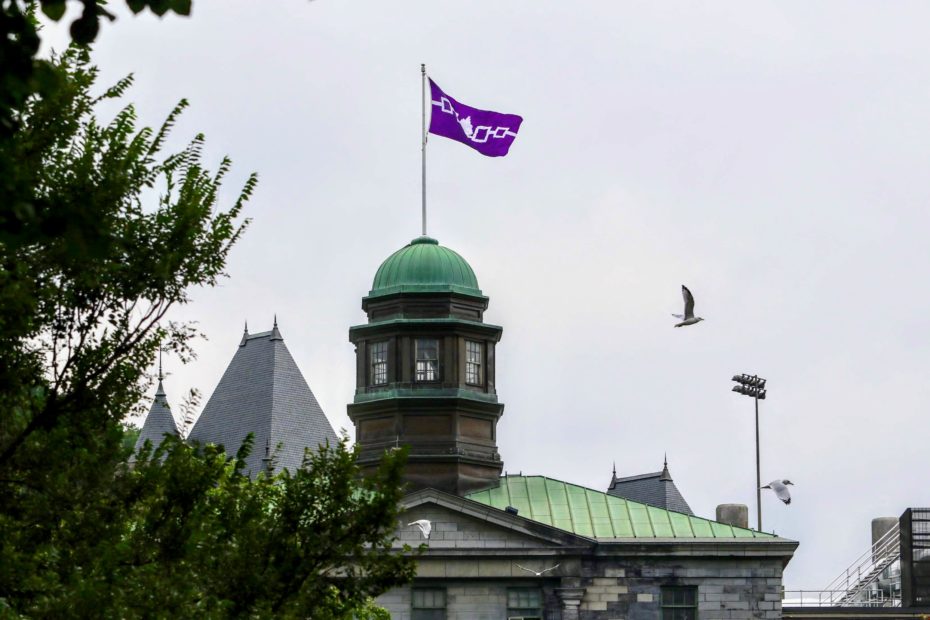
Partway through today’s ceremony to raise the Hiawatha Belt Flag above the McCall MacBain Arts Building, the sun broke through ominous-looking clouds as Principal Suzanne Fortier was speaking. “We were all a bit worried that we would be rained on but I’m glad to see a few rays of sun,” said the Principal. “I hope they are signs for the future.”
The sun broke through the clouds on more than one occasion during the ceremony, illuminating the Hiawatha Belt Flag as it flew from the iconic cupola. It marks one of the few times a flag other than the traditional McGill flag has been raised from the McCall MacBain Arts Building
52 Calls to Action
This new tradition began on a gorgeous June 21 day in 2018, fulfilling one of the 52 Calls to Action in the 2017 final report of the Provost’s Task Force on Indigenous Studies and Indigenous Education.
Provost Christopher Manfredi stuck the Task Force in 2016, in response to the 2015 report of the Truth and Reconciliation Commission of Canada. The mandate of the Provost’s Task Force is to engage and collaborate with McGill and Indigenous communities to identify, explore and advance ideas and initiatives that will enhance the presence and success of Indigenous students, staff and faculty.
A centuries-old symbol marking unity and peace between the Seneca, Cayuga, Onondaga, Oneida and Mohawk nations, the Hiawatha Belt Flag is raised at McGill every June 21, to mark Canada’s National Indigenous Peoples Day.
“People are learning”
At today’s ceremony, Michael Loft, retired Professor of Social Work and one of the people who initiated the implementation of the Flag ceremony, remembered coming to campus as an undergrad in 1976. He spoke about how beautiful the campus was, but how bereft it was of a physical Indigenous presence. “There was nothing Indigenous here,” he said. “No inkling.”
He spoke of his efforts to celebrate symbols of Indigenous culture – specifically the Hochelaga Rock and the Hiawatha Belt Flag – with positions of prominence on campus. And, he spoke of his “innate happiness” at the progress being made at his alma mater.
“Because once McGill starts to do things, they don’t stop,” said Loft, a member of the Mohawk community at Kahnawake. “In 100 years, this flag will still be going up. The Hochelaga Rock will still be there when your children graduate. They will go by and they will check the Rock and say ‘Native people used to live here.’ People are learning and that’s what it’s all about.”
“We’ve had a tough month with the [discovery of the remains of 215 children at the site of the former Kamloops Residential School]. It has been rough,” said Loft. “My wife Is a survivor of Residential schools and my dad was a survivor. So, it’s had a big impact on us. But… there’s been a lot of change and I cannot express how lucky we are and how glad I am that things are moving here,” said Loft. “I just hope that trend continues and more good things can happen.”
Walking together on the path toward reconciliation
Principal Fortier took the opportunity to look at important initiatives undertaken at McGill recently, saying “the aim is to build respectful reciprocal relationships with the larger Indigenous community.”
Among others, she highlighted the partnership agreement between the Gault Nature Reserve and the Grand Conseil de la Nation Waban-Aki, the Virtual Scarf ceremony during Convocation, and the Mellon Indigenous Writer in Residence and Indigenous Artist in Residence programs
“These are important steps but we know they are not the last steps,” said Principal Fortier. “They are continuing steps toward our journey together for reconciliation… I am very happy that through these efforts we will continue to benefit from the guidance of Indigenous community partners.”
Responsibility to future generations
Kevin Deer, another McGill alumnus, spoke about the interconnectedness of the world and people’s responsibility to protect the Earth.
“To us everything is a circle. The Earth Mother is a round. Our elder Brother Sun is round our Grandmother the Moon is round. We come here for a time and we’re going back home. We are already guaranteed original and everlasting life,” said Deer, a teacher at the Karihwanoron Mohawk Immersion School in Kahnawake and a Longhouse Faith Keeper. “But while we’re here we are asked to have an attitude of gratitude. And all of our sacred songs, our dances, our rituals and our speeches are all about the continuance of life.
“And we don’t only consider us, the living. We have a responsibility to look to those future generations whose faces have not come out of the Mother Earth,” said Deer, who graduated from McGill in 1996 with a Bachelors of Education in First Nations Education.
“Imagine if the whole world understood this Indigenous wisdom and knowledge that I’m sharing with you right now. There would be no more war, there would be no more rape, there would be no more killing, there would be no more destruction of the natural world because people would understand that this is their Mother,” said Deer, pointing to the ground. “We’d be singing songs of joy and happiness and trying to improve this beautiful creation. So that when those unborn generations come they will inherit a happy, safe, clean, beautiful, loving, peaceful home. That’s our responsibility to them.”
Watch the video of the flag raising ceremony.
